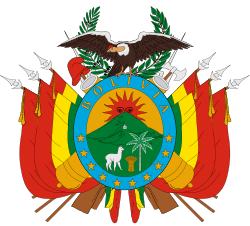Bolivian general election, 1980
 |
|---|
| This article is part of a series on the politics and government of Bolivia |
|
Presidency |
General elections were held in Bolivia on 29 June 1980, the third in three years.[1] As no candidate in the presidential elections received a majority of the vote, the National Congress was required to elect a President on 6 August. With Hernán Siles Zuazo of the Democratic and Popular Union the favourite to win the Congressional ballot, the process was disrupted on 17 July by the military coup led by General Luis García Meza Tejada. However, Meza was pressured to resign on 4 August 1981, resulting in General Celso Torrelio becoming President. In July 1982 he was replaced by General Guido Vildoso, who was named by the high command to return the country to democratic rule. On 17 September 1982, during a general strike that brought the country close to civil war, the military decided to step down, to reconvene the National Congress elected in 1980, and to accept its choice of President. Accordingly, the National Congress revalidated the 1980 election results on 23 September and overwhelmingly elected Hernán Siles Zuazo as President on 5 October. He subsequently assumed the presidency on 10 October 1982.[2]
Background
General elections had previously been held in July 1978, the first since 1966, with several military coups taking place during the late 1960s and early 1970s.[1] Although Juan Pereda of the Nationalist Union of the People won the presidential elections, more votes were cast than there were registered voters.[3] After examining a number of allegations of fraud and other irregularities, the Electoral Court decided to annul the results on 20 July.[4] The following day, Pereda was installed as President following a military coup. Pereda himself was overthrown by yet another military coup in November, which saw General David Padilla assume the presidency,[5] promising to hold fresh elections in July the following year.[6]
The 1979 general elections saw no candidate for President receive over 50% of the vote, and when Congress was required to elect a President, it failed to do so after three ballots. Instead, Senate leader Wálter Guevara was elected to serve as Interim President for a year on 8 August.[7] However, Guevara was later overthrown by another military coup led by Alberto Natusch on 31 October.
Campaign
Several alliances were formed for the elections:[8]
Results

Congressional ballot (October 5, 1982)
| Candidate | Party | Votes | % |
|---|---|---|---|
| Hernán Siles Zuazo | Democratic and Popular Union | 113 | 79.6 |
| Hugo Banzer | Nationalist Democratic Action | 29 | 20.4 |
| Invalid/blank votes | 4 | – | |
| Total | 146 | 100 | |
| Registered voters/turnout | 157 | 93.0 | |
| Source: Ontiveros[9] | |||
References
- 1 2 Nohlen, D (2005) Elections in the Americas: A data handbook, Volume II, p133 ISBN 978-0-19-928358-3
- ↑ Bolivia - Transition to Democracy Library of Congress Country Studies
- ↑ Nohlen, p143
- ↑ Waltraud Q Morales (2003) A brief history of Bolivia New York: Facts On File, p195
- ↑ Nohlen, p157
- ↑ 1979 IPU
- ↑ Report on the situation of human rights in the Republic of Bolivia: Chapter IV: Political rights Archived February 1, 2012, at the Wayback Machine. OAS
- ↑ Nohlen, p139
- ↑ Luis Iriarte Ontiveros (1983) Democracia y el Congreso del 80 La Paz: Editorial Amerindia, p44